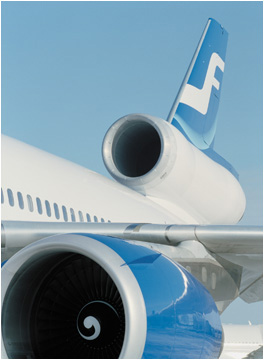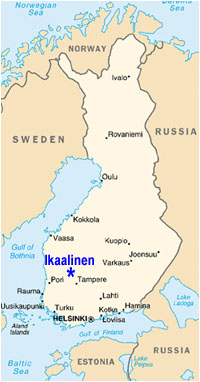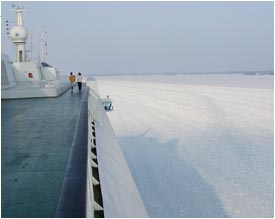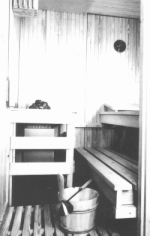 There
are excellent flight connections to Finland from all over the world. Finnair
and other airlines have scheduled flights to Helsinki from most major
cities in Europe, as well as from New York, San Francisco, Cairo, Bangkok,
Singapore, Beijing and Tokyo. There
are excellent flight connections to Finland from all over the world. Finnair
and other airlines have scheduled flights to Helsinki from most major
cities in Europe, as well as from New York, San Francisco, Cairo, Bangkok,
Singapore, Beijing and Tokyo.
Vantaa Airport serving Helsinki is a modern and efficient gateway to many
parts of Europe and the Far East.
Twenty-two other international airlines offer flights to Helsinki. There
are no departure taxes when leaving Finland.
In addition to air transportation,
arrival by land and boat from Sweden, Russia and Estonia are common
and quite easy. Baltic ferries run from Sweden, Estonia and Germany
to Helsinki and Turku.
The ferries are impressive seagoing craft and have been compared to
hotels and shopping plazas; they actually make more money from duty-free
shops than they do from passenger tickets.
|
|
 Tourist
Visas: Most western nationals, including Americans, citizens of
EU countries, Australians, Canadians, New Zealanders, Malaysians, Singaporeans
and most South Americans do not need a visa for travel into Finland. Tourist
Visas: Most western nationals, including Americans, citizens of
EU countries, Australians, Canadians, New Zealanders, Malaysians, Singaporeans
and most South Americans do not need a visa for travel into Finland.
Time: GMT/UTC
+2
Electricity: 220V,
50Hz
Weights & measures: Metric
Currency: The Finnish currency unit is the Euro. Finland was
one of the 12 EU countries that started using euro cash in 2002.
Languages: Finland has two official languages: Finnish and Swedish.
In most areas you will find the general population able to converse
in English quite well, especially the younger generation. (Finnish,
a Finno-Ugric language, is spoken by 91,3% and Swedish by 5,4 % of the
population. Sami (Lappish) is the mother tongue of about 1,700 people.)
|
|

- 5.2 million, 17 inhabitants
per square kilometre
- 67% live in towns or
urban areas, 33% in rural areas
- Helsinki (pop. 560,000)
- Espoo (pop. 221,000)
- Tampere (pop. 199,000)
- Vantaa (pop. 182,000)
- Turku (pop. 174,000)
- Oulu (pop. 124,000)
- About one million people
live in the Helsinki metropolitan area.
- Finland has a Sami
(Lapp) population of 6,500.
|
|
 Whatever
time of year you visit Finland, there's something happening. Most museums
and galleries are open year-round, and there is as much to do in the
depths of winter as there is at the height of summer. Whatever
time of year you visit Finland, there's something happening. Most museums
and galleries are open year-round, and there is as much to do in the
depths of winter as there is at the height of summer.
Finland is situated in northern Europe between the 60th and 70th parallels
of latitude. A quarter of its total area lies north of the Arctic Circle.
Finland's neighbouring countries are Sweden, Norway and Russia, which
have land borders with Finland, and Estonia across the Gulf of Finland.
Much of the country is a gently undulating plateau of worn bedrock and
boreal forests, presenting a striking mixture of wooded hills and waters.
 The
climate is marked by cold winters and warm summers. The mean annual
temperature in the capital, Helsinki, is 5.3 degrees Celsius. The highest
daytime temperature in southern Finland during the summer occasionally
rises to almost 30 degrees. The
climate is marked by cold winters and warm summers. The mean annual
temperature in the capital, Helsinki, is 5.3 degrees Celsius. The highest
daytime temperature in southern Finland during the summer occasionally
rises to almost 30 degrees.
During the winter months, particularly in January and February, temperatures
of minus 20 Celsius are not uncommon. In the far north, beyond the Arctic
Circle, the sun does not set for about 73 days, producing the white
nights of summer. In the same region, during the dark winter period,
the sun remains below the horizon for 51 days, creating the polar night
known in Finnish as kaamos.
 No
trip to Finland is complete without a visit to the Sauna. Finland is
the land of the sauna and the Finns are a nation of sauna-enthusiasts.
Finland has a population of 5.1 million and 1.7 million saunas —
one for every three inhabitants. The sauna is considered an age-old
Finnish feature, although it is not a Finnish invention and certainly
not the private property of the Finns. In the late 19th century, sauna-bathing
was practiced in the Old World all the way from the Baltic Sea to the
Ural Mountains. The sauna was also common among the other Finnic nations
in the Baltic region — the Estonians, the Karelians, the Veps and
the Livonians. Other traditional sauna-users include many Slavic, Baltic
(Latvians, Lithuanians) and eastern Finno-Ugric peoples as well as Turkic
Tatars. No
trip to Finland is complete without a visit to the Sauna. Finland is
the land of the sauna and the Finns are a nation of sauna-enthusiasts.
Finland has a population of 5.1 million and 1.7 million saunas —
one for every three inhabitants. The sauna is considered an age-old
Finnish feature, although it is not a Finnish invention and certainly
not the private property of the Finns. In the late 19th century, sauna-bathing
was practiced in the Old World all the way from the Baltic Sea to the
Ural Mountains. The sauna was also common among the other Finnic nations
in the Baltic region — the Estonians, the Karelians, the Veps and
the Livonians. Other traditional sauna-users include many Slavic, Baltic
(Latvians, Lithuanians) and eastern Finno-Ugric peoples as well as Turkic
Tatars.
 The
traditional sauna is a wooden building where the bathers sit on benches
splashing water on the hot stones of the stove and gently beating themselves
with leafy birch whisks. ‘Sauna’, the most commonly borrowed
Finnish word, has spread from Finnish to several world languages, although
the Finns believe not always in its original sense. The
traditional sauna is a wooden building where the bathers sit on benches
splashing water on the hot stones of the stove and gently beating themselves
with leafy birch whisks. ‘Sauna’, the most commonly borrowed
Finnish word, has spread from Finnish to several world languages, although
the Finns believe not always in its original sense.
The expression ‘to have a sauna’ covers the whole bathing
process and includes several repeated periods of perspiring in the heat
and the steam, known as löyly, produced by the water thrown on
the stones. Löyly is described as the spirit of the sauna. It is
a Finno-Ugric word going back 7,000 years.
For more information on Finland and the wonders that await you in this
spectacular country, please visit:
|
 There
are excellent flight connections to Finland from all over the world. Finnair
and other airlines have scheduled flights to Helsinki from most major
cities in Europe, as well as from New York, San Francisco, Cairo, Bangkok,
Singapore, Beijing and Tokyo.
There
are excellent flight connections to Finland from all over the world. Finnair
and other airlines have scheduled flights to Helsinki from most major
cities in Europe, as well as from New York, San Francisco, Cairo, Bangkok,
Singapore, Beijing and Tokyo.
 Tourist
Visas: Most western nationals, including Americans, citizens of
EU countries, Australians, Canadians, New Zealanders, Malaysians, Singaporeans
and most South Americans do not need a visa for travel into Finland.
Tourist
Visas: Most western nationals, including Americans, citizens of
EU countries, Australians, Canadians, New Zealanders, Malaysians, Singaporeans
and most South Americans do not need a visa for travel into Finland.
 Whatever
time of year you visit Finland, there's something happening. Most museums
and galleries are open year-round, and there is as much to do in the
depths of winter as there is at the height of summer.
Whatever
time of year you visit Finland, there's something happening. Most museums
and galleries are open year-round, and there is as much to do in the
depths of winter as there is at the height of summer.  The
climate is marked by cold winters and warm summers. The mean annual
temperature in the capital, Helsinki, is 5.3 degrees Celsius. The highest
daytime temperature in southern Finland during the summer occasionally
rises to almost 30 degrees.
The
climate is marked by cold winters and warm summers. The mean annual
temperature in the capital, Helsinki, is 5.3 degrees Celsius. The highest
daytime temperature in southern Finland during the summer occasionally
rises to almost 30 degrees.  No
trip to Finland is complete without a visit to the Sauna. Finland is
the land of the sauna and the Finns are a nation of sauna-enthusiasts.
Finland has a population of 5.1 million and 1.7 million saunas —
one for every three inhabitants. The sauna is considered an age-old
Finnish feature, although it is not a Finnish invention and certainly
not the private property of the Finns. In the late 19th century, sauna-bathing
was practiced in the Old World all the way from the Baltic Sea to the
Ural Mountains. The sauna was also common among the other Finnic nations
in the Baltic region — the Estonians, the Karelians, the Veps and
the Livonians. Other traditional sauna-users include many Slavic, Baltic
(Latvians, Lithuanians) and eastern Finno-Ugric peoples as well as Turkic
Tatars.
No
trip to Finland is complete without a visit to the Sauna. Finland is
the land of the sauna and the Finns are a nation of sauna-enthusiasts.
Finland has a population of 5.1 million and 1.7 million saunas —
one for every three inhabitants. The sauna is considered an age-old
Finnish feature, although it is not a Finnish invention and certainly
not the private property of the Finns. In the late 19th century, sauna-bathing
was practiced in the Old World all the way from the Baltic Sea to the
Ural Mountains. The sauna was also common among the other Finnic nations
in the Baltic region — the Estonians, the Karelians, the Veps and
the Livonians. Other traditional sauna-users include many Slavic, Baltic
(Latvians, Lithuanians) and eastern Finno-Ugric peoples as well as Turkic
Tatars. The
traditional sauna is a wooden building where the bathers sit on benches
splashing water on the hot stones of the stove and gently beating themselves
with leafy birch whisks. ‘Sauna’, the most commonly borrowed
Finnish word, has spread from Finnish to several world languages, although
the Finns believe not always in its original sense.
The
traditional sauna is a wooden building where the bathers sit on benches
splashing water on the hot stones of the stove and gently beating themselves
with leafy birch whisks. ‘Sauna’, the most commonly borrowed
Finnish word, has spread from Finnish to several world languages, although
the Finns believe not always in its original sense.